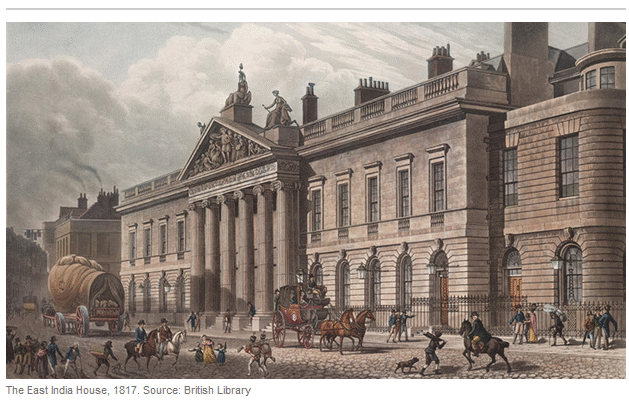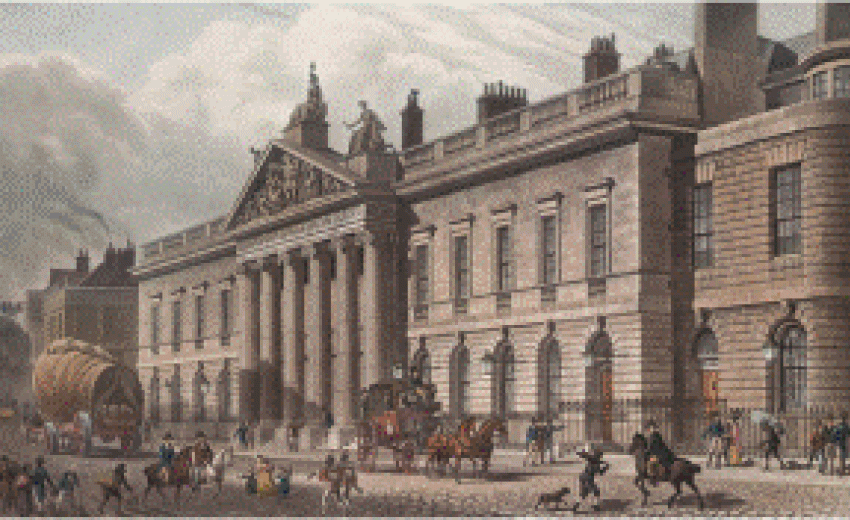
Mar 12, 2013: For an institution that has been defunct for almost 150 years, the East India Company still evokes powerful reactions across the world.
Last year, when the Indian government debated allowing foreign companies to open supermarkets there, protesters shouted: “This is the return of the East India Company!” In the U.K., the East India Company’s extraordinary rise and fall have uncanny parallels with the stock-market bubbles and government bailouts that have shaken the economy over the past decade.
And little wonder: At the heart of the company’s story are eternal questions about how to cope with the powers and perils of large multinational corporations.
Established by royal charter in 1600 with a monopoly on all trade with Asia, the East India Company had many incarnations in its almost 275-year run.
For the first half of its existence, it remained a commercial supplicant, exporting bullion to pay for Asia’s luxury goods: first spices, then textiles and tea. Along the way, it became an early model for today’s joint-stock corporation and pioneered new management techniques for long- distance supply chains.
It also created a series of lifestyle revolutions in 18th- century England. Daniel Defoe described in 1708 how the company’s calicoes, shipped from India, “crept into our houses, our closets, our bedchambers.” This calico boom prompted fierce resistance from Britain’s weavers, who felt threatened by a flood of cheap Asian imports. In 1720, the government responded with a ban on Indian calicoes, and it was behind this protectionist wall that the Industrial Revolution would take shape.
Asian Intrusions
One market may have closed, but the East India Company refocused its efforts on the growing demand for Chinese tea on both sides of the Atlantic.
Meanwhile, at the company’s headquarters on Leadenhall Street in London, annual general meetings had become the arena for fearsome battles between management and shareholders and between rival management cliques.
These boardroom fights intensified following the Battle of Plassey in June 1757, when the company used a combination of force and fraud to place a puppet on the throne of Bengal. The company then loaded the contents of the Bengal treasury onto a fleet of 100 boats and sent them downriver to its base in Calcutta.
In one stroke, Robert Clive, who had engineered the victory, netted 2.5 million pounds for the company and 234,000 pounds for himself. (Today, this would be equivalent to a 262 million-pound corporate windfall and a cool 25 million-pound success fee for Clive.) The flow of wealth from Europe to Asia would now be reversed, and the East India Company’s shares soared on London’s markets.
After the boom, however, came the bust. When drought struck Bengal in 1769, the company raised taxes and refused to intervene; contemporaries estimated that as many as 10 million people died in the resulting famine. Back in London, the East India Company’s shares slumped in response to the conflict in South India. This provoked a wider credit crisis, forcing the company’s directors to beg the government for a bailout in the summer of 1772. The East India Company’s centrality to Britain’s commercial and imperial ambitions meant that it was the original “too big to fail” corporation.
Tea Party
The British government tried to ensure that the East India Company would recover sufficiently to pay back its debts. One of the company’s assets was an immense amount of unsold tea. Instead of just importing the tea to Britain and then letting wholesalers ship it across the Atlantic, the company was granted the right to export the tea itself to Britain’s American colonies.
The arrival of this controversial corporation inflamed a flagging protest against Britain’s taxes on tea. The result was the Boston Tea Party of December 1773. Here, Chinese tea bought with Bengali money by a British corporation was dumped in the sea by American patriots dressed as “Indians.” This was globalization 18th-century style.
The East India Company’s fall from grace provided a compelling case study for Adam Smith in “The Wealth of Nations.” Smith argued that the impositions placed on European colonies, and the practices of monopoly corporations, had prevented the Age of Discovery from resulting in a generalized spread of commercial benefits. By the time he published the book’s third edition, Smith was even more convinced of “the Absurdity and hurtfulness of almost all our chartered companies.” And he added a new critique of the joint-stock model of ownership: “Negligence and profusion must always prevail, more or less, in the management of such a company,” he concluded.
The revenue that tea provided enabled the East India Company to eventually recover. But this glamorous trade rested on a deadly secret: By the early 19th century, growth in the tea business was paid for by the mass smuggling of opium from the company’s Indian territories into China. And in India, the company had switched its attention from commerce to conquest, using its private army to take over the bulk of the subcontinent.
An Anachronism
In Britain, free-trade advocates inspired by Smith had won the removal of the company’s monopoly on trade with India in 1813 and with China in 1833. Increasingly an anachronism, the East India Company continued as the administrator of its conquests in India until its sepoys rebelled in 1857.
John Stuart Mill, the company’s leading executive, defended his employer against ferocious attack in Parliament, but he couldn’t stop the inevitable. The company was stripped of its operational responsibilities, and the British Raj began.
If you go to the site of East India House today, you’ll find no plaque outside to mark that this was where the world’s most powerful corporation once dominated both trade and territories. With the global economy now reorienting toward Asia, understanding the East India Company’s extraordinary journey may be more important than ever if we want to understand the shocks that are still to come.
(Nick Robins is the author of “The Corporation that Changed the World: How the East India Company Shaped the Modern Multinational.” The opinions expressed are his own.)

